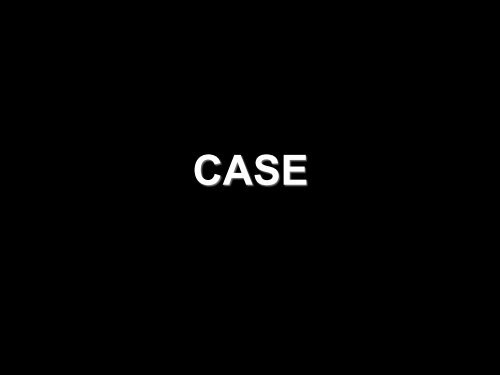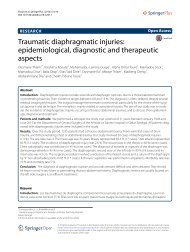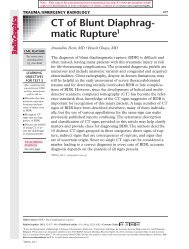Diaph rupture pdf case
Create successful ePaper yourself
Turn your PDF publications into a flip-book with our unique Google optimized e-Paper software.
CASE
FINDINGS<br />
Left diaphragmatic <strong>rupture</strong>
DIAPHRAGMATIC RUPTURE<br />
•Blunt trauma (6% of patients after major blunt<br />
trauma)<br />
•Penetrating trauma<br />
• If the diagnosis is missed, patients may develop<br />
intrathoracic herniation and strangulation , with<br />
morbility and mortality of up to 50%
CT FINDINGS 2002: 7<br />
Variable Sensitivity Specificity<br />
Collar sign 24 100<br />
Direct visualization<br />
of injury<br />
36 95<br />
Thick crus 36 77<br />
Dependent<br />
viscera sign<br />
Herniation without<br />
collar sign<br />
52 71<br />
8 95<br />
Trajectory 36 100<br />
Active<br />
extravasation of<br />
contrast material<br />
8 100<br />
Larici et al, AJR 2002;179:451451-457
CT FINDINGS 2012:19
CT SIGNS<br />
DIRECT SIGNS<br />
• Segmental <strong>Diaph</strong>ragmatic defect<br />
• Dandgling diaphragm<br />
• Absent diaphragm sign<br />
INDIRECT SIGNS (related<br />
to herniation)<br />
• Herniation through a defect sign<br />
• Collar sign<br />
• Hump and Band signs<br />
• Dependent viscera<br />
• Sinus cutoff sign<br />
• Abdominal content peripheral to<br />
the diaphragm or to the lung<br />
• Elevated abdominal organ signs
• INDIRECT SIGNS RELATED TO LOSS OF THE<br />
BORDER BETWEEN THE THORAX AND ABDOMEN<br />
• CT SIGNS OF UNCERTAIN OR CONTROVERSIAL<br />
ORIGIN<br />
• Thickening of the diaphragm sign<br />
• <strong>Diaph</strong>ragmatic or peridiaphragmatic contrast medium<br />
extravasation<br />
• Hypoenhanced diaphragm sign<br />
• Fractured rib<br />
INDIRECT OR<br />
CONTROVERSIAL SIGNS
Waistlike constriction of<br />
stomach suggesting<br />
herniation of the stomach<br />
through injured<br />
diaphragm (Collar sign)<br />
Larici et al, AJR 2002;179:451451-457
Because the patient lie supine<br />
at CT examination, if the<br />
diaphragm has been <strong>rupture</strong>d,<br />
the herniated viscera (bowel or<br />
solid organs) are no longer<br />
supported posteriorly by the<br />
injured diaphragm and fall to a<br />
dependent position against<br />
posterior ribs. (Dependent<br />
Viscera Sign)<br />
Bergin et al,AJR 2001;177:1137-1140
<strong>Diaph</strong>ragmatic discontinuity<br />
and active arterial<br />
extravasation<br />
Notes: The entire diaphragm often cannot be completely visualized with crosssectional<br />
imaging. Posterolateral diaphragmatic defect are seen at CT in<br />
approximately 6% of healthy adults.<br />
Larici et al, AJR 2002;179:451451-457
…be prepared to suggest the presence of an<br />
injury on the basis of a single CT finding!!<br />
Coronal and sagittal reformatted images<br />
could be “helpful”.







